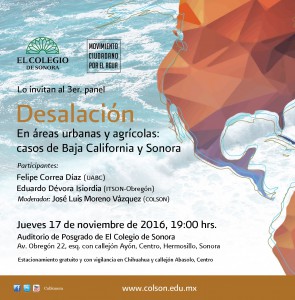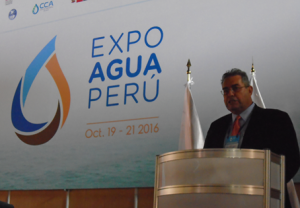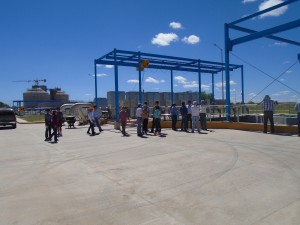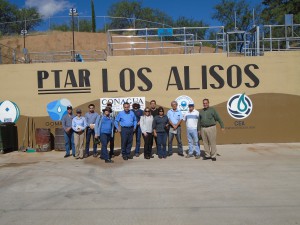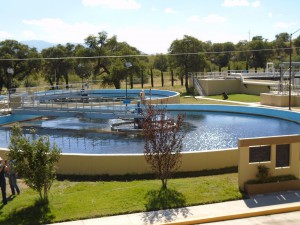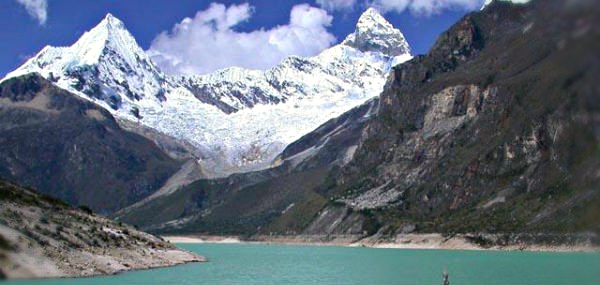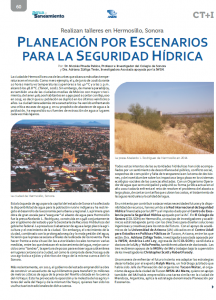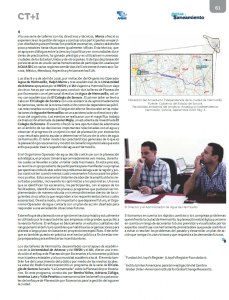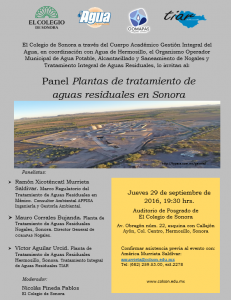Expo agua Perú 2016
En el marco de las políticas que el nuevo gobierno de la República del Perú, encabezado por el Presidente Pedro Pablo Kuczynski, está emprendiendo para alcanzar la cobertura total de agua potable y saneamiento para el año 2021, se desarrolló la Expo agua Perú 2016 (http://expoaguaperu.com), en la ciudad de Lima, los días 19, 20 y 21 de octubre.
Panel de Plantas de Tratamiento de Aguas Residuales en Sonora
El 29 de septiembre de 2016 en el Colegio de Sonora se llevó a cabo el panel sobre plantas de tratamiento de aguas residuales donde participo como organizadores el Dr. Nicolás Pineda Pablos y Dr. José Luis Moreno Vázquez. La participación como panelistas invitados fueron el M.S.C Ramón Xicoténcatl Murrieta Saldivar, Ingeniero Mauro Bujanda y el Ingeniero Víctor Aguilar Urcid presentando temas de interés sobre PTAR y su marco regulatorio en Sonora.
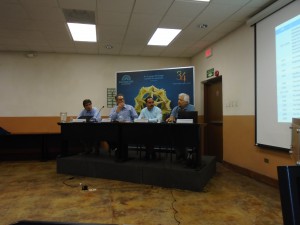
Visita Planta de Tratamiento de Aguas Residuales. Hermosillo, Sonora
El día 22 de Septiembre de 2016 un grupo de investigadores, maestro y estudiantes de El Colegio de Sonora visitaron la PTAR de Hermosillo, Sonora que se encuentra al final del Camino del Seri actualmente no está funcionando cabe mencionar el por qué no cuentan con energía eléctrica para comenzar a operar desde el año 2015 está sin funcionamiento han realizado pruebas con un transformador que la empresa rento.
Visita Planta de Tratamiento de Aguas Residuales Los Alisos. Nogales, Sonora
El 21 de Septiembre de 2016, un grupo de investigadores, estudiantes y funcionarios visitaron la Planta de Tratamiento de Aguas Residuales Los Alisos ubicada en el ejido de Cíbuta en la periferia de la ciudad de Nogales, Sonora. La construcción de esta planta se inició en el año 2010 con un costo de 88 millones de pesos que fueron aportados por la EPA (Environmental Protection Agency) de los Estados Unidos, así como por la CONAGUA, la CEA y del Municipio de Nogales, Sonora. La energía eléctrica para la operación de la planta se obtiene con 3,920 paneles solares que generan aproximadamente 700 kW. Esta generación de energía les ahorra un 10 % de inversión en energía, y en la noche la planta opera con la energía de CFE.
El proceso de tratamiento de las aguas residuales consta de seis etapas. La capacidad instalada es para tratar un flujo de 220 litros por segundos (lps) y trabaja con un 95% de eficiencia. Actualmente, debido a lluvias, está excedida y está procesando 290 lps. Además se está construyendo una ampliación que le permitirá tratar 330 lps.
Diversity as a key element of urban resilience
As climate change increases the frequency of storm events, flooding risk, prolonged drought, and other hazards, enhancing resilience becomes the goal of cities worldwide. How can societies prepare for and address a multitude of disturbances that can threaten the functioning of a city? A perhaps-unlikely answer is to increase diversity in all its forms. Economic, industrial, environmental, administrative, institutional, and sociocultural diversity are intertwined in cities, and diversity in all of these systems enhances resilience. Diversity as a key element of urban resilience.
In the ecological sciences, increasing biodiversity is the best strategy for achieving resilience. When there are multiple species it is more likely that the extinction of some species will not completely change the state of an ecosystem. As one species becomes extinct, another similar one fills that niche, performing the same ecological functions of the extinct species and preserving the functioning of the entire ecosystem. In this sense, a system is resilient when the functioning of the system continues in spite of disturbances.
Enlace: http://www.watersecuritynetwork.org/diversity-as-a-key-element-of-urban-resilience/
Research and decision making for sustainable mountain ecosystems: IWSN at international forum
In recent years, we have witnessed significant changes in mountain ecosystems and glaciers. The accelerated retreat of glaciers and the increased number of lagoons are indicators of this process, and even if it means there is a major water reserve, there are risks of disasters that may affect nearby populations with weak adaptive capacity.
Peru, which has great ecological wealth, is considered one of the countries most vulnerable to climate change, aggravated by persistent socioeconomic gaps and conflicts arising from the management of natural resources. Indeed, the National Water Authority of Peru reported the loss of more than 40% of its glaciers, which represents a threat to water, food, energy and ecological security.
Enlace: http://www.watersecuritynetwork.org/research-and-decision-making-for-sustainable-mountain-ecosystems-iwsn-at-international-forum/
Promoting water conservation at the household level in Hermosillo, Mexico

Ana Melissa, Maria Alejandra, and Miryam Fernanda were awarded the 2016 IWSN Student Prize in July. They are undergraduate students at Universidad de Sonora in Hermosillo, Mexico. This summer, they conducted a brief but informative study and submitted a complete report to the local water agency. Here, they explain their research.
Introduction
The world is currently facing a severe water crisis. Therefore, it is extremely necessary to be aware of the value that water has for our lives, for the ecosystems, and the role it plays in our survival and our wellbeing. For this reason, it is essential to achieve water security, because it provides water in acceptable quantity and quality, for our health, and for the survival of every living organism. Water security is about having a sustainable water source, for different social uses including economic development, health, food production, energy, and for the environment.

